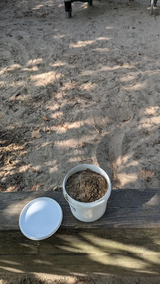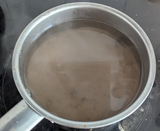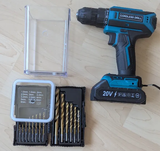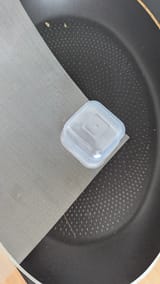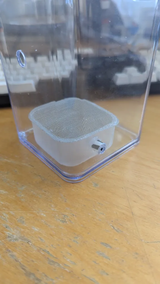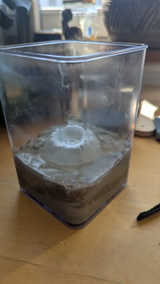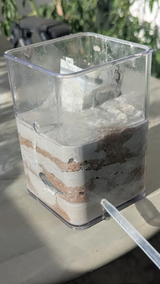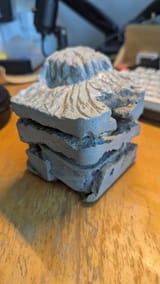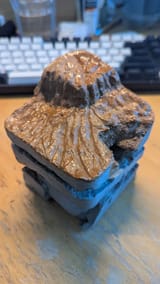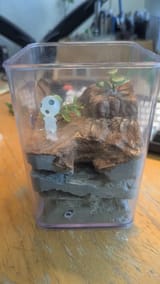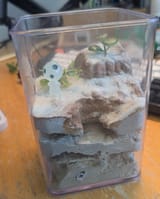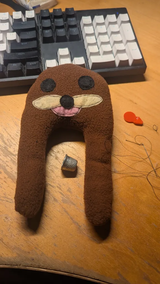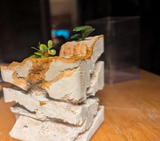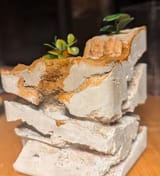Ant formicarium buildalong
I want to build an ant enclosure, more formally known as a "formicarium" myself because ant enclosures are overpriced as shit and the materials needed are pretty cheap all things considered.
I'll document it here similarly to a cookalong thread in /ck/, so whoever is interested can come along for the ride.
I'm also a rentoid and only have shit tier tools, which both means if you want to do what I'll do in this thread it'll be easy with minimal equipment, and I'll likely fuck up, meaning you get to at least laugh at me.
We'll build 2 (ideally) ant enclosures; one made of ytong (a porous building material) and the other made of grout.
Picrel is what I got for the project, all pretty cheap materials. Price estimates will be behind the items.
>For the Ytong nest
This is probably the cheapest nest you can build, and surprisingly decent for that price.
- 1 block ytong. This one is 60x5x20 cm big and cost me 1.50€. Density of 0.5 g/cm^3 iirc.
- Acrylic or plastic sheet (25x50x0.2cm for me) 3€, or picture frame (1.5€)
- 8 Magnets that are somewhat flat at the top (4€/6, so 5.33€ for 8)
That's ~10€ for the entire nest or less.
>For the Grout nest
- See-through plastic container (3€)
- Grout (7€/2kg, you need maybe a quarter, also if you order in bulk it's much cheaper, let's say 3€)
- Sand (Free or 1€)
- A cheap small plastic container (1€ for 6, say 0.5€)
- Plastic drinking straw (0.2€)
- Metal mesh (How fine depends on species, at least 30 mesh, 7€ for 4 A4 pieces, we'll use maybe 1/8th of one sheet, say 1€ total)
That's also ~10€, though slightly more initial cost as you likely have to buy more than you need for these things.
>Tools and misc stuff
You'll need a drill, a saw (optional but helps), and a chisel or screwdriver you don't care too much about.
I also got some fake plants for decoration later.
I'll document it here similarly to a cookalong thread in /ck/, so whoever is interested can come along for the ride.
I'm also a rentoid and only have shit tier tools, which both means if you want to do what I'll do in this thread it'll be easy with minimal equipment, and I'll likely fuck up, meaning you get to at least laugh at me.
We'll build 2 (ideally) ant enclosures; one made of ytong (a porous building material) and the other made of grout.
Picrel is what I got for the project, all pretty cheap materials. Price estimates will be behind the items.
>For the Ytong nest
This is probably the cheapest nest you can build, and surprisingly decent for that price.
- 1 block ytong. This one is 60x5x20 cm big and cost me 1.50€. Density of 0.5 g/cm^3 iirc.
- Acrylic or plastic sheet (25x50x0.2cm for me) 3€, or picture frame (1.5€)
- 8 Magnets that are somewhat flat at the top (4€/6, so 5.33€ for 8)
That's ~10€ for the entire nest or less.
>For the Grout nest
- See-through plastic container (3€)
- Grout (7€/2kg, you need maybe a quarter, also if you order in bulk it's much cheaper, let's say 3€)
- Sand (Free or 1€)
- A cheap small plastic container (1€ for 6, say 0.5€)
- Plastic drinking straw (0.2€)
- Metal mesh (How fine depends on species, at least 30 mesh, 7€ for 4 A4 pieces, we'll use maybe 1/8th of one sheet, say 1€ total)
That's also ~10€, though slightly more initial cost as you likely have to buy more than you need for these things.
>Tools and misc stuff
You'll need a drill, a saw (optional but helps), and a chisel or screwdriver you don't care too much about.
I also got some fake plants for decoration later.

